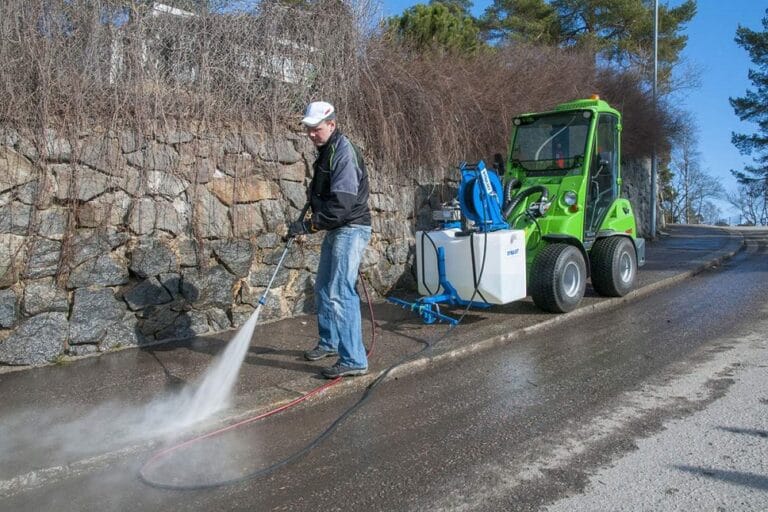How To Pressure Wash Mold On Concrete
Pressure washing is one of the most effective ways to remove the stains and other unwanted build ups on surfaces created by a variety of different things.
One of the most common issues found on many concrete surfaces in particular, is the build up of mold and mildew.
It is important to take action when concrete surfaces are showing signs of mold accumulation, not to have clean looking concrete, but to prevent degradation as well. Mold build up on concrete will cause it to become porous, which in turn will allow moisture to invade and cause damage over time.
Maintaining the integrity of your concrete is incredibly important for many reasons, and should always be a priority.
Let’s talk more about this, and provide some useful advice regarding how to safely and efficiently pressure wash mold on concrete.
Can Mold Be Removed With A Pressure Washer?
The first question that needs to be answered is whether or not mold build up on concrete and other surfaces can effectively be removed by a pressure washer.
The answer is yes, a pressure washer is definitely a great option for removing mold and mildew.
This method will work for virtually any surface including different types of wood, vinyl, brick and concrete. A pressure washer used properly in tandem with the right cleaning products or detergents will definitely do the trick.
It is important to use a non-harmful and non-corrosive detergent mixture so that both your pressure washing machine and surface to be cleaned do not get damaged by toxic chemicals.
In the following sections we will discuss in detail what chemicals are safe to use, as well as provide a step-by-step pressure washing mold removal guide.
Should You Use Chemicals?
The most effective way to remove the mold on concrete surfaces is in fact to use a detergent, bleach or other type of chemical based mixture.
However, it is important to do your research and make sure you are using the right chemicals in the proper proportions, in order to protect your equipment and your concrete from damage.
There are a number of chemicals/detergents that are acceptable to use on concrete including baking soda, certain detergents, vinegar, bleach and concrete cleaners (usually made from concentrated alkaline soap).
The presence of acid in concrete cleaners is something to watch out for, as acid can potentially eat away at the top layer of cement or any sealer that has been previously applied.
Step-By-Step Guide For Removing Concrete Mold With A Pressure Washer
Step 1: Initial Bleach Scrub
In order to ensure a thorough clean, start by scrubbing the affected concrete area with a bleach and hot water mixture.
Combine a quarter cup of liquid bleach with approximately 1 gallon of hot water in a bucket. Use a hard bristle scrub brush or push broom and scrub down the area until it has been fully saturated.
Be sure to wear protective gloves for this step as bleach is a skin irritant.
Step 2: Pressure Wash With Detergent
Next, set up your pressure washer and find a mold and mildew detergent that is safe to use in your pressure washer and will not cause any equipment damage.
Fill your pressure washer’s reservoir with the detergent, make sure everything is in order and turn the machine on.
Spray your concrete by working in small manageable sections, moving in a nice consistent horizontal pattern from top to bottom. Use a low pressure detergent nozzle for this step, and adjust your spraying distance as appropriate.
Allow the detergent to soak into the surface and act on the mold and mildew for at least a few minutes.
Step 3: High Pressure Rinse & Repeat
Once you have performed the detergent wash on your concrete surface and allowed the solution to sink in and take effect on the mold build up, it is time for the final step.
It is now time to thoroughly rinse off all of the detergent, which will bring with it the built up mold and mildew in order to reveal a nice clean concrete surface. Switch to a pressure washing nozzle that provides a wide fan, and more water pressure than the nozzle you were using to spray the detergent in step 2.
Fill your reservoir with nice clean warm water and rinse the surface from top to bottom, working in small sections the same way you did while applying the detergent. Rinsing the detergent off in this step with a fairly powerful jet stream will remove the majority of the mold build up that has accumulated on your concrete surface.
After one round of rinsing, evaluate the condition of the surface and decide whether another pass over or two would benefit the condition of the concrete. Work methodically and be sure to do a thorough job.
The end result should be a nice concrete surface that looks just as nice and clean as the day it was poured!
Conclusion
Maintaining the aesthetics, stability and integrity of concrete surfaces in both residential and commercial settings is something that many customers will invest in.
Ensuring that these surfaces not only look appealing, but will maintain their structural integrity over long periods of time is imperative.









